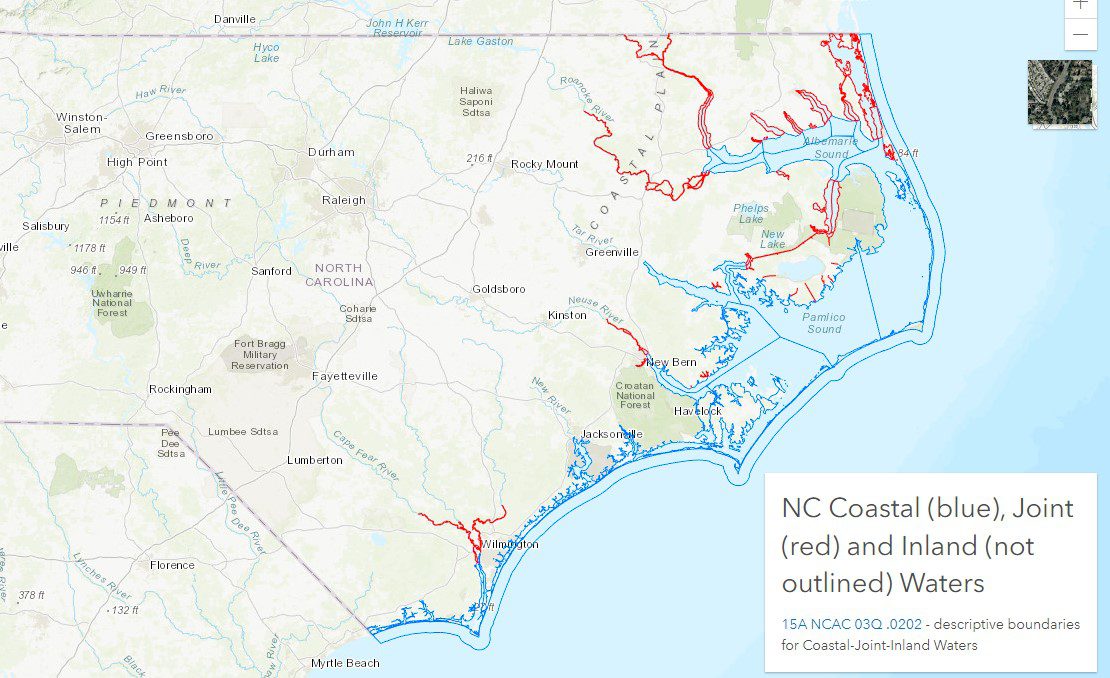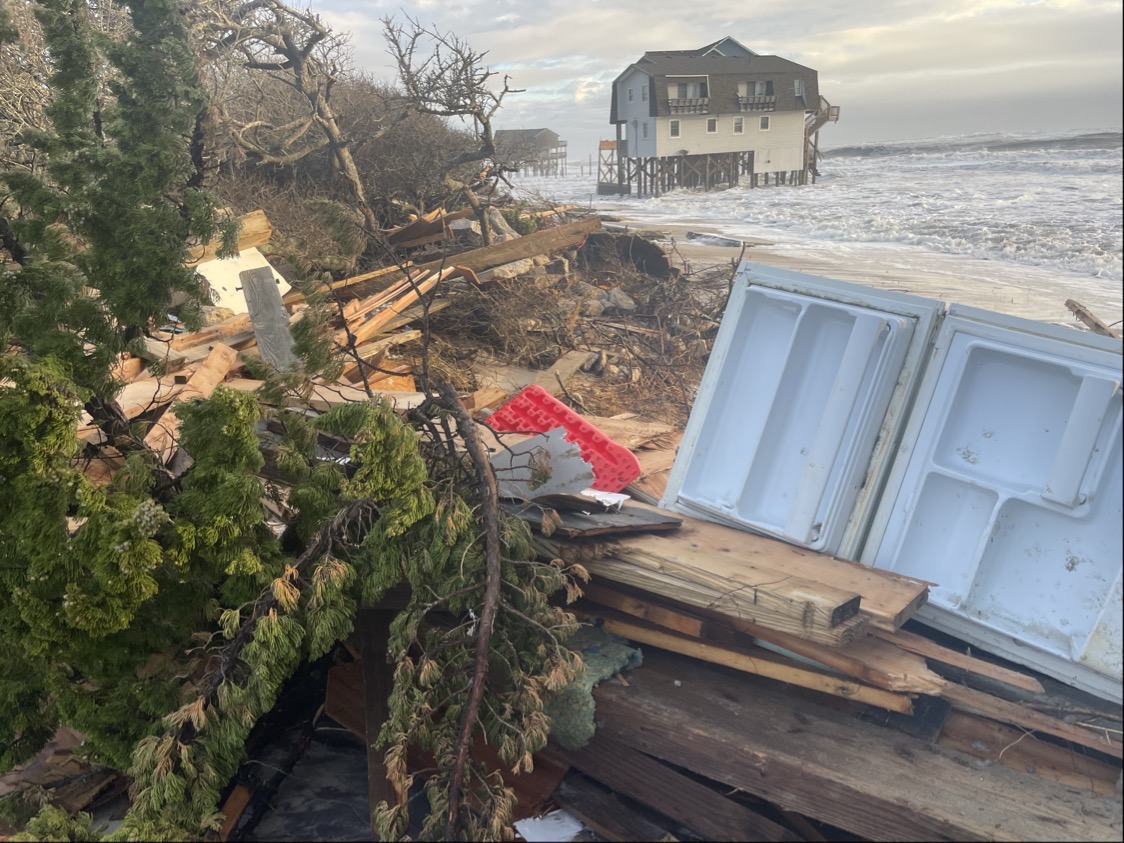
Third and final in a series investigating why, after years of consistent seasons for inland, joint and coastal waters, recreational anglers found themselves negotiating different flounder and mullet rules in 2023.
Disagreements between the two commissions that manage state waters began to flare in 2019 after they formed an interagency committee to work on the required 10-year review on rules for the joint waters they both manage.
Supporter Spotlight
With the threat of these rules expiring in 2022 looming over the Wildlife Resources Commission that manages inland waters and the Marine Fisheries Commission manages coastal waters and the two never coming to an agreement, the governor’s office directed the agencies in February 2022 to adopt the existing joint rules without any changes.
The joint rules address scope and purpose, the classification of inland, coastal and joint waters, posting dividing lines, applicability of rules and special regulations for joint waters, and estuarine striped bass management.
Though there was mounting conflict evident between the agencies, what highlighted the impasse was the two recreational flounder seasons in September 2023. The WRC season was the first two weeks and MFC’s was the second two weeks, leading to confusion and even warnings issued to some fishers for breaking one agency’s rules.
North Carolina Fisheries Association Executive Director Glenn Skinner told Coastal Review that with the two agencies trying to decide who has authority over what, “you’ve got a lot of stakeholders that are really caught in the middle. And that’s a shame whenever it comes to that.”
What kept the inland and coastal seasons concurrent was a 2011 Wildlife Resources Commission rule to mirror the recreational seatrout, flounder and red drum seasons set by the Marine Fisheries Commission or Division of Marine Fisheries, which carries out the Marine Fisheries Commission’s rules. The Wildlife Resources Commission amended this rule in late 2021 to establish its own flounder season and limits as well as dozens of species-specific rules that went into effect March 2023.
Supporter Spotlight
Division of Marine Fisheries Public Information Officer Tricia Smith recently explained to Coastal Review that the 2023 southern flounder seasons “demonstrated the real-world consequences of competing regulations for a single species: confusion for anglers and the potential for significant overharvest of a stock in need of rebuilding.”
Division of Marine Fisheries and Marine Fisheries Commission specifically warned the Wildlife Resources Commission of these consequences when the Wildlife Resources Commission proposed separate rules for a host of marine and estuarine species, she said. “The WRC adopted these rules despite the MFC and DMF’s objections.”
Wildlife Resources Commission Inland Waters Chief Christian Waters said that the commission’s goal is to be consistent with the species management of the Marine Fisheries Commission and Division of Marine Fisheries to provide anglers the opportunity to fish and eliminate unnecessary confusion.
“We acknowledge that the angling public suffers when seasons and limits are not consistent. However, we can only effectively implement any regulatory change in our jurisdictional waters per our statutory requirements and responsibilities when MFC and DMF communicate with us in a timely manner about management decisions being considered. We believe this would ultimately eliminate confusion for all staff involved and our customer – the public,” Waters said.
Capt. Jess Hawkins, who operates an ecotours business in Carteret County, previously worked 30 years with the division as a marine biologist.
Hawkins said that for most people who do not follow fisheries regulations or environmental protection measures, these disparate fish restrictions probably do not mean much and may appear to be an example of government inefficiency.
“However, in reality they mean much more to North Carolina citizens,” he explained in an email. “We have a situation where one state agency, created by our General Assembly with jurisdiction over freshwater (inland) fish are creating different regulations on primarily coastal/marine fish that differ from another state agency which was created by our elected officials to manage and conserve those fish.”
Hawkins said that any scientific data used to objectively manage those fish are collected by the coastal fisheries agency.
“The conflicting limits jeopardize science-based efforts on these fish, some of which are experiencing population declines based on that info. Enforcement officers are placed in a very difficult situation where they have to deal with a scenario where fishermen legally taking fish in areas become illegal when taking their catch back to the boat ramp where they launched,” he said. “If officers decide to write a citation, then our district attorneys and judges have to determine what is ‘just’ in such a situation. Also, up until recently the agency primarily dealing with freshwater fish mirrored those of the coastal agency, preventing such scenarios.”
Looking ahead
In response to the conflicting seasons, Smith said the Marine Fisheries Commission, during its November 2023 meeting, began rulemaking to amend the joint rules with “a straightforward approach,” which is to allow the Marine Fisheries Commission and Wildlife Resources Commission to regulate species based upon the respective expertise of each agency.
“Under the proposed amendments, the WRC would continue to set regulations for freshwater species in joint fishing waters, while the MFC would set regulations for marine and estuarine species,” Smith said.
She said the proposed amendments align regulatory authority with management responsibility and expertise, and it ensures that the state remains in compliance with the multiple federal and regional bodies with oversight of coastwide stocks that frequent joint waters.
“The two agencies would continue to share enforcement authority in joint waters under a single set of regulations, rather than separate, and, at times, competing regulations,” she said, adding staff are finalizing the regulatory impact analysis for submission to Office of State Budget and Management.
Waters said that the wildlife commission voted Oct. 26, 2023, to move forward with proposed rule text as part of its 2024-25 annual rulemaking cycle with a public comment period and hearings for amendments to inland fisheries rules.
“Of the proposals in the package, one would reduce the daily creel limit for Flounder from four fish to one fish. A second one would reaffirm the WRC’s authority over certain species designated as inland game fish in all public fishing waters and clarify the size and creel limits which apply,” he explained in an email. “A third one would reaffirm the WRC’s authority over all fishes taken by hook and line in Joint Fishing Waters and clarify the size and creel limits, seasons, and restrictions on species that may be sold.”
The public comment period for the proposed rules opened Dec. 1 and will end Tuesday, Jan. 30. The website has information on how to submit comments. There will be a public hearing at 7 p.m. Wednesday, Jan. 17, at the Craven County Courthouse in New Bern and a virtual hearing 7 p.m. Thursday, Jan. 18. Hearings were scheduled for Jan. 9 in Asheboro and Jan. 11 in Clyde, as well.
Joint water rules discussion
Early in the conversation, completely eliminating joint waters was proposed, which would cause boundaries for inland and coastal waters to change.
Wildlife Resources Commission Chairman Monty Crump explained to Coastal Review that the point of getting rid of the delineation of waters — to just have coastal and inland waters, and get rid of joint jurisdictions – is to avoid the overlapping we have today.
The Wildlife Resources Commission published more than 50 proposed rules in the Jan. 18, 2022, North Carolina Register. The 11 that would have led to significant changes to the definitions of inland, coastal and joint waters were withdrawn before the rules went before the Rules Review Commission at its May 2022 meeting. The rules went into effect March 2023.
Division of Marine Fisheries Director Kathy Rawls in a March 2022 letter said that while they appreciate the Wildlife Resources Commission withdrawing the rules while both commissions work toward updating the joint rules, the remaining 46 rules continue to conflict with the division’s and Marine Fisheries Commission’s interpretation of authority in joint fishing waters.
Waters said that the action taken in early 2022 was to readopt joint rules to meet the deadline for the periodic review. When the governor’s office directed both agencies to adopt existing joint rules with no changes, there was further direction for the two to develop a comprehensive solution to address joint rules and jurisdictional waters.
“A proposal was developed to modify current jurisdictional boundary lines and eliminate the designation of joint fishing waters, which should have addressed most of the issues with joint rules,” Waters explained.
A draft memorandum of agreement was written for the Wildlife Resources Commission and Marine Fisheries Commission to consider that would commit each to “conducting a comprehensive assessment of the proposal including, but not limited to, impacts to joint rules, recreational and commercial consistencies, fisheries management and regulations, other state agencies, and local governments,” Waters said.
The Wildlife Resources Commission during a committee meeting Aug. 17, 2022, agreed with the draft agreement, pending Marine Fisheries Commission review. The Marine Fisheries Commission at its Nov. 17, 2022, meeting, discussed the agreement, but took no action.
“There has been no further activity on the designation of jurisdictional waters since then,” Waters said and there are no current efforts by Wildlife Resources Commission to reconsider the designation of jurisdictional waters, specifically joint fishing waters boundaries.
He continued that the jurisdictional waters designation review was not to “merely eliminate joint fishing waters, but a major goal was to ensure WRC and MFC have primary jurisdiction in those waters which are predominately inhabited by the species and supporting habitats under their respective management authority.”
Additionally, Waters said, the purpose was to enhance consistency with the intent of a general statute Relating to Resources and “to provide a consistent, predictable, common-sense approach for constituents. While this wouldn’t eliminate the need for collaboration between WRC and DMF/MFC, it would substantially reduce future conflicts among regulations.”
Smith echoed that there had been no recent developments on changing boundaries for joint waters.
“DMF and the MFC are focused on the more immediate need for consistent regulation in joint waters that is aligned with statutorily mandated fishery management plans,” she said, adding that the recently proposed amendments would address that need.

Joint water rules ripple effect
Smith explained that the concept of eliminating joint waters was considered, “but it became apparent that moving boundary lines, particularly ones that would cause areas to change from joint or coastal to inland, would have unintended consequences to other regulatory programs that far exceeded any potential benefits.”
These concerns were voiced in letters to the Wildlife Resources Commission by the state Department of Environmental Quality on the proposed rules back in 2019, she said.
The NCDEQ letter as well as those from the Division of Marine Fisheries, Division of Coastal Management and Coastal Resources Commission were made available to view in the Wildlife Resources Commission’s April 14, 2022, agenda packet, as part of the the public comments on the proposed rules.
Division of Coastal Management Director Braxton Davis wrote that if the joint rules were allowed to expire automatically, or be repealed as proposed unilaterally by the Wildlife Resources Commission, there would be significant changes for where the division and the Coastal Resources Commission could enforce more protective rules for estuarine shorelines and estuarine waters.
Coastal Resources Commission Chairman Renee Cahoon reiterated during the Marine Fisheries Commission’s November 2022 meeting that the boundary of the existing coastal and inland waters established by the joint rules had significance far beyond jurisdiction for fisheries regulation.
“Several state laws for which the Coastal Resources Commission is responsible, including the Coastal Area Management Act and the state Dredge and Fill Act, refer to the boundary between Coastal and Inland Waters as the extent of the state’s estuarine resources,” Cahoon said.
“As a result, if the Marine Fisheries Commission and the WRC changed the boundary of coastal-inland waters or repeal the rule establishing that boundary, the estuarine shoreline and waters critical to the state’s estuarine fisheries could be removed from protection under Coastal Management, water quality and habitat protection programs,” Cahoon said. “At the very least, changing this boundary could cause significant uncertainty about where the Coastal Resources Commission’s more protective estuarine shoreline rules could be enforced.”
Cahoon added that she had also submitted in March 2022 comments to the Rules Review Commission after learning that the Wildlife Resources Commission had proposed, amended and adopted rules published in the North Carolina Register Jan. 18, 2022, that would “unilaterally change the jurisdictional boundary between coastal and inland waterways.”
Skinner said that from a commercial fishing perspective, it would be a problem for more waters to be classified as inland waters for commercial fisheries. Commercial gear has always been allowed in joint waters but under the Wildlife Resources Commission’s current rules, commercial gear is prohibited.
Hawkins said that the proposal to change classifications of waters by the freshwater fish agency should worry people because, if it had passed, it would have harmed efforts that had been developed over the last 40 years to protect critical coastal fish habitat.
“These proposed reclassifications were pursued even over the strong objections of the agencies responsible for the protection of critical fish habitat and coastal/marine fishes, even writing the current Governor about those concerns,” Hawkins said.
“The Department that the General Assembly empowered for environmental and natural resource protection even objected to the proposals, but the inland fish agency continued to pursue those proposals,” Hawkins said. “The public and our leaders should ask what was broken that caused such a drastic change from policies that were in place to conserve and protect our resources the last 40 years.”
Waters explained that for these previous proposals that reduced or eliminated joint fishing waters, a comprehensive assessment was never conducted that would have better defined any impacts to Coastal Resources Commission rules and potential fixes.
As part of that assessment, “a question that needed to be considered is whether CRC/DCM rules should be linked to where fisheries are executed and managed? Or instead, should the area where CRC/DCM rules apply be defined based on the habitats being conserved and protected? One concern is that habitats currently have different levels of protection and regulation simply based on whether the location is in inland fishing waters compared to joint and coastal fishing waters, Waters explained.
‘One Mission, One Commission’
The nonprofit North Carolina Wildlife Federation proposed in late 2019, “One Mission, One Commission,” which would consolidate the Division of Marine Fisheries into the North Carolina Wildlife Resources Commission.
Wildlife Federation CEO Tim Gestwicki said it doesn’t make sense to have two agencies managing the same species, yet managing those species differently depending on an invisible line in the water.
“The agencies are extremely duplicative with both having administrative, information technology, enforcement, human resources, and budget sections. A single agency, consistent with many east coast states, is a model that is good for the resource and the taxpayer. This is not a unique proposal. Most recently Florida consolidated heir agencies as we have proposed,” he said.
Gestwicki explained that the Wildlife Federation believes that the more holistic approach of the Wildlife Resources Commission being made up of members appointed by the governor, Senate, and House to represent all regions of the state and provide a voice and perspective from all user groups of public trust resources.
“On the other hand, the MFC is selected only by the Governor with the statutory requirement for 4 of the 9 members to have a vested financial interest in the fisheries they manage,” he said, adding the Wildlife Resources Commission has resource successes except for those issues that they must work with the Division of Marine Fisheries and Marine Fisheries Commission to resolve.
“We hear repeatedly from elected officials and stakeholders that the system is broken, something needs to be done, etc etc.,” he wrote in the email.
“The science based, resource first decision making that is typical of the WRC is countermanded by the economic and political decisions by the MFC. Combining the two agencies in some fashion to provide consistency of conservation theory and the precautionary approach in managing our fish and wildlife makes good biological sense that will ultimately reap economic rewards to our state,” he said.
Gestwicki said that the organization has recommended “One Mission, One Commission” publicly, “now it’s up to elected officials to make it happen.”
Smith said Combining the Division of Marine Fisheries and Marine Fisheries Commission with the Wildlife Resources Commission had been studied by the legislature on numerous occasions but had never been recommended.
“While the two agencies share a common statutory charge, each agency has a distinct regulatory framework and area of expertise,” she said, explaining that the Division of Marine Fisheries and the Marine Fisheries Commission are ultimately concerned with the long-term viability of the state’s marine and estuarine resources, rather than the organizational structure through which they are managed.
Waters said that the Wildlife Resources Commission had not taken a position on the proposed merger.







